 |
|||||||||||||||
|
|||||||||||||||
 |
||
|
 |
||||||||||||
|
||||||||||||
 |
|||||||||||||||||||||||||||||||||||||||
|
|||||||||||||||||||||||||||||||||||||||
|

|
THE TRASHING OF THE CHRIST By Tim Graham, MRC Director of Media Analysis Executive Summary | Press Release | Introduction
In 2004, the networks showed hostility to a more orthodox vision of Jesus in the movie The Passion of the Christ. So MRC analysts compared coverage of the year before The Passion (March 2003 through February 2004) and the year before The DaVinci Code (May 19, 2005 to May 18, 2006) on the morning, evening, prime-time and late-night news programs of ABC, CBS, and NBC.
1. The DaVinci Code received an enormous publicity push from the broadcast networks. In the year before its cinematic release, The DaVinci Code attracted 99 segments on network news shows, compared to 66 for The Passion. Most of those came on morning shows. By far, the biggest Code promoter was NBC’s Today, which provided more stories (38) than the other two network morning shows combined (29). By contrast, NBC was third-place in Passion segments (11).
There were 67 segments on the morning shows alone: 38 stories on NBC’s Today, 15 on ABC’s Good Morning America, 13 on CBS’s The Early Show, and one on CBS’s Sunday Morning. Five NBC stories, three CBS stories and one ABC story were brief, anchor-read items. There were 16 segments on the prime-time and late-night magazine/interview programs. ABC’s Nightline carried six segments, NBC’s Dateline aired nine, and CBS’s 60 Minutes aired one.
The Passion of the Christ attracted 15 magazine/interview segments: an entire hour of Primetime, an entire hour of Dateline, and a Nightline. It also drew a controversial 60 Minutes commentary by Andy Rooney in which he joked God spoke to him and God called Mel Gibson "a real nut case." It should be noted that not every story on The DaVinci Code in this year-long study dealt explicitly with the movie. Sometimes, The DaVinci Code was not just the movie, and not just the book, but sort of blurred together into a fad, a craze. These numbers for The DaVinci Code do not include all of the casual mentions in passing, and all of the promotional verbiage leading up to these segments. NBC’s Today often had three, four, even five "coming up" messages in a show, all with the words "The DaVinci Code" in them. If Doubleday or Sony Pictures had paid for the advertising time the networks provided for free, it would have been a hefty bill. These numbers also do not include the network coverage that’s emerged from first buzz on the book version emerged in June 2003, through May of 2005. Most notably, that publicity would include a one-hour Primetime special by ABC anchor Elizabeth Vargas which softly recounted tthe Code’s "legends" without much opposition on November 3, 2003 and again on August 4, 2004. NBC’s Dateline also aired an hour-long DaVinci Code special on April 10, 2005, which spun the legends for 50 minutes, and then allowed experts to debunk it for five minutes at the end. It replayed within the study period on June 25, 2005. It could also be added that even large-budget studio movies often failed to get a fraction of the buzz the networks gave The DaVinci Code. Consider some examples. On ABC’s Good Morning America in 2005, King Kong drew only three brief mentions in passing before it debuted in mid-December. So far in 2006, Dead Man’s Chest, the sequel to the smash summer hit Pirates of the Caribbean – filmed by Disney, the parent company of ABC – has only been mentioned once, and it debuts on July 7. Or the same glance can be directed at Universal Pictures, now part of the NBC conglomerate. The DaVinci Code has drawn much greater interest from NBC’s Today than the sister company’s releases recently: three for Spike Lee’s The Inside Man, one segment on the Bush-mocking American Dreamz, and zero on Curious George. Perhaps a movie needs to have some real-world import, some blend of fact and fiction, to generate high interest from the news media? Surprisingly, Today only had five segments on United 93, the film re-enacting the actual 9-11 hijacking of the airplane that crashed in a field in Pennsylvania instead of its intended target in Washington. The passion for The DaVinci Code is obvious.
2. The Passion of the Christ was treated as a social problem – the biggest TV anti-Semitism story of that year – while The DaVinci Code was presented more often as an "intriguing" theory rather than threatening or offensive to Christians. Nearly every one of the 66 network segments on The Passion touched on complaints about its supposedly incendiary portrayal of Jews. But only 27 of the 98 Code segments focused on Christian and Catholic protests. The network scrutiny of Gibson and his alleged anti-Semitism was intense months before the movie came out. Within our study period, NBC’s Matt Lauer pressed the question in a September 8, 2003 interview with Peter Boyer of The New Yorker: "The Anti-Defamation League expressed concern over whether it would portray the Jews as, quote, ‘bloodthirsty, sadistic, and money-hungry enemies of Jesus.’ You spoke to the head of the ADL. Did he think it was an anti-Semitic movie?" On February 16, 2004, Diane Sawyer began by welcoming viewers to ABC’s one-hour special on The Passion, "the film that set off an explosion of debate, controversy, and feeling in America....And not only between Christians and Jews, but Christians and Christians, historians and scholars, true believers and secularists, and everyone who falls somewhere in between." Sawyer reported Gibson’s film suggests "echoes, the critics say, of what were called ‘Passion plays,’ which through the ages, were used to inflame Christians against their Jewish neighbors. Ghettos were sacked, the Jewish populations terrorized." (Sawyer didn’t relate that Passion plays are read or performed annually around the world in millions of Christian churches without outbursts of anti-Semitic violence.) Sawyer asked Gibson, point blank: "Are you anti-Semitic?" She brought in the Nazi angle: "Hitler went to a passion play and came away saying that, you know, this is a precious tool in the fight against Judaism." The networks commonly presented as a reasonable possibility the outbreak of anti-Semitic hatred or violence based on Gibson’s film. The networks never provided the Anti-Defamation League or other Jewish and secular critics with any countering scrutiny, as in: What if the film isn’t anti-Semitic and doesn’t lead to any anti-Semitic incidents? Or: How can you attack a film you haven’t seen? Since Catholics and the Catholic group Opus Dei were harshly attacked by Dan Brown, maligned as a murderous group in the book and film, the three networks did give them time to respond – but it’s important to note that the coverage was not a one-sided portrayal of outrage, like the Anti-Defamation League received. All three networks also noted Opus Dei critics, like former member Tammy DiNicola, who charged that she had been brainwashed like a cult member during her time in the group. On ABC, John Donvan expressed an extra measure of skepticism, underlining for the audience that Linda Ruff, the Opus Dei member they were profiling, was handed to ABC by Opus Dei publicists: "Now, we want to say clearly that Opus Dei found Linda for us. And the organization, with the movie about to come out, is deeply concerned about getting a head start on some good public relations." The networks were clearly enamored of The DaVinci Code as an "intriguing" theory – even though they could have been asking Dan Brown or the filmmakers point blank if they were "anti-Christian" or "anti-Catholic," or to take a page from Jewish groups critical of The Passion, merely "money-hungry enemies of Jesus." On May 23, 2005, ABC’s Good Morning America spent a large chunk of its air time in an attempt to "span the globe on our hunt for the real DaVinci Code," as Diane Sawyer put it. She called it "a fascinating morning of mystery, myth, and controversy." Echoing the Elizabeth Vargas special from 2003, ABC’s Bill Weir couched the Code as an enthralling set of Christianity-debunking questions: "What if we told you that Mary Magdalene was not a prostitute as believed, but rather the wife of Jesus Christ? That she had his baby? That their holy bloodline survives to this day? And that the Catholic Church knows this and is suppressing this stunning truth? And what if this truth was protected by a secret society of visionaries, including the artist, Leonardo da Vinci? Extraordinary claims, to be sure, capturing the world’s imagination because they appear in the mega-best seller The DaVinci Code." That tone suffused other shows as well. ABC’s December 29, 2005 special on the theory that there was a female pope in the Middle Ages, a "Pope Joan," began with Diane Sawyer calling it "as riveting as The DaVinci Code" and "an enigma to rival The DaVinci Code." On February 13, during Olympics coverage in Turin, Matt Lauer announced a story on the Shroud of Turin with this introduction: "It is a story every bit as intriguing as The DaVinci Code." The overall narrative of Code coverage was that it was upsetting only to a minority, and fascinating to everyone else. Left unexplored: This theory was "intriguing" to whom? It’s possible that the networks find "intriguing" talk to be sales chatter, stay-tuned talk. But it also can sound like joy in poking at Christianity and those perceived to be least "inclusive" in their view of its fundamental rightness – conservative Christians.
3. In their push to promote The DaVinci Code, the networks routinely failed to address the aspect of the book that most offended Christian sensitivities: the claim that Christianity itself is a lie. The networks showed their lack of belief or interest in religion as they almost always failed to examine Brown’s most contentious charge: that Jesus was not the Son of God. While many noted the scandalous claim of a sexual relationship between Jesus and Mary Magdalene, only six stories explained the Code’s denial of the divinity of Jesus. It’s right there, on page 233, the claim that the divinity of Jesus was not established in the Messiah’s crucifixion and resurrection, but cynically manufactured at the early church’s Council of Nicaea in 325: "My dear," Teabing declared, "until that moment in history, Jesus was viewed by His followers as a mortal prophet...a great and powerful man, but a man nonetheless. A mortal." (Italics Brown’s.) Without the divinity of Christ, where is Christianity? The DaVinci Code posits that it’s a massive conspiracy, a fraud, a crude invention ("nothing in Christianity is original") with an unreliable Bible ("The Bible is a product of man, my dear, not of God"). CBS never noticed that crucial issue in its coverage. ABC and NBC explained it three times each. ABC’s Jake Tapper also noted the Jesus-as-mortal line last August. ABC carried two explanations in the last few days before the movie’s premiere, with evangelical expert Darrell Bock elaborating on Good Morning America and Nightline on May 16: "Well, the premise is, if Jesus had married, this would have shown He’s not divine, so we need to have some coverup so we can protect His divinity." Network reporters regularly failed to connect the dots as Bock simply did here. They routinely described Brown’s Mary-Magdalene-marriage line without noting it had any effect on the divinity of Jesus, as if Christians were merely disturbed by the savior having sex.
4. While the faith of millions of Americans, Christianity, is singled out for criticism, with one "fascinating" fictional detail after another, the networks either refused to air or barely aired mild Mohammed cartoons out of great sensitivity to American Muslims. At the same time that Christianity is questioned as a false religion in The DaVinci Code, the three major network news divisions have demonstrated an exquisite sensitivity to American Muslims. Earlier this year, they danced around the sensitive subject of threatened violence against mostly mild Danish cartoons mocking the prophet Muhammad. It is nearly impossible to imagine that the network newscasters would promote a book with a fictional plot this ruthlessly declaring a religious faith to be false, indeed maliciously false, with any other major world religion. One cannot imagine any other religion but Christianity being picked apart in-depth on television: no hour-long special rankling Jews (and Christians) by maligning Moses, no deconstructing the Buddha or the Bhagavad Gita, not even shredding Scientology, and certainly not a minute daring to challenge the fundamental truth or falsehood of Islam. Two of the three networks, so daring or unthinking in their airing of repudiations of Christianity and its creed, crumbled at the prospect of being targeted for violence or accused of airing news that’s insulting:
– On February 6, Brian Montopoli reported on the CBS News website "Public Eye" that CBS decided to avoid any image of the cartoons on February 6. "We could explain it, so we didn't need to show it," said Linda Mason, CBS News senior vice president for standards and special projects, comparing the decision to one not to show dead soldiers. "Any rendering of Muhammad is an insult to Muslims, and desecration is even worse," she says, adding that the decision was made out of a desire not to unnecessarily offend, not because of the demonstrations or "out of fear of retribution." (CBS was so sensitive they even scrubbed CBSNews.com of a photo of a man holding a newspaper featuring an image of the cartoon. Mike Sims of the website crowed: "I think we've proven we can tell the story without offending Muslims.") Reporter Richard Roth, a regular correspondent this year on the DaVinci Code beat, briefly announced the network’s no-cartoon decision on air on February 2. – NBC’s Campbell Brown announced on "The Daily Nightly" weblog on February 2: "After some discussion in our editorial meeting, we have decided not to show the cartoons explicitly. We are trying to treat this issue with care and sensitivity while still bringing you the story." That night on the Nightly News, reporter Dawna Friesen noted the policy on air: "Their outrage triggered by cartoons, which we've chosen not to show, first published in a Danish newspaper. One depicts the prophet Muhammad wearing a turban that looks like a bomb." Because the Muslim cartoon sensitivities made reporters feel awkward, the story quickly came and went in the first week of February, without any real concerns that sensitivity to a religious group led to self-censorship. But the appeal of the daring attack on Christianity in The DaVinci Code showed that this kind of sensitivity is not an across-the-board policy.
5. While Mel Gibson was attacked and psychoanalyzed for his religious beliefs, DaVinci Code author Dan Brown and filmmakers Ron Howard and Brian Grazer were never personally examined or challenged: about their personal religious beliefs, or their willingness to milk controversy, play fast and loose with facts, and offend Christians with the objective of making millions. Whenever the networks decided to address fact and fiction in The DaVinci Code, they almost always found it was stuffed with falsehoods. But they never focused on the idea that Brown, Grazer, or Howard should be criticized for being too casual with the truth. It cannot be said that the network news divisions failed to correct errors and falsehoods in The DaVinci Code – there were plenty of examples of that, even if they largely ignored the ultimate divinity question. But those reporters never seemed to hold the peddlers of false "fact" accountable. To examine how author Dan Brown was interviewed, you have to rewind back to 2003, outside our study period, and well before the movie began filming. When Brown granted an interview to NBC on June 9, 2003 – well before he vanished from network interviews – he claimed his book divulged a "great historical secret," spurring Matt Lauer to inquire: "How much of this is based on reality in terms of things that actually occurred?" Brown boasted: "Absolutely all of it. Obviously there are – Robert Langdon is fictional, but all of the art, architecture, secret rituals, and secret societies, all of that is historical fact." The closest Lauer claim to religious objections was this: "Christianity. That can be a mine field for an author. And people take that very seriously. Were you worried about that at all?" Brown said merely he was "very curious," and then added, "I’m happy to say there was just an instant tidal wave of good will and enthusiasm toward the book. There were a handful of people for whom it was a little bit shocking, but the vast majority loved it." (Compare that to Lauer’s pounding on Gibson’s alleged anti-Semitism, referenced earlier in the report in section 2.) The same song and dance came in an interview with ABC’s Charles Gibson on November 3, 2003, the morning of the big one-hour Primetime special promoting the "legend" in the book. When asked by Gibson "how much of it’s true, how much of it’s not," Brown dodged: "the people who ask me how much is true need to realize this theory about Mary Magdalene has been around for centuries. It’s not my theory." Gibson asked: "If you were writing it as a nonfiction book, how would it have been different?" Brown replied: "I don’t think it would have." Brown showed his dogmatic fervor for the anti-Christian view: "I began the research for The DaVinci Code as a skeptic. I entirely expected, as I researched this book, to disprove this theory. And after numerous trips to Europe, about two years of research, I really became a believer." (Italics mine.) Now compare that with how ABC’s Diane Sawyer hounded Mel Gibson about matters of fact a couple of months later on Primetime: "What about the historians who say that the Gospels were written long after Jesus died, and are not merely fact, but political points of views and metaphors? Historians, you know, have argued that in fact it was not written at the time [of Christ]. These [gospel writers] were not eyewitnesses." Gibson protested that there certainly were eyewitnesses, and Sawyer insisted: "But historians have said they don’t think so." Sawyer pounded Gibson about his addictions, and how they led him to return to his Catholic beginnings. But Sawyer went further than that: on Good Morning America, she interviewed TV pop-psychologist Drew Pinsky about Gibson’s mental problems, with this line of questioning: "We know that spirituality is fundamental to AA [Alcoholics Anonymous]. Is there any rehab program that really says, hey, do it on your own, you don't need that?" And so on: "And you've said that the relationship between the movie, which concentrates on the suffering, the Passion, the suffering of Jesus, and what [Gibson] went through during this darkest time." And so on: "He's talked about intensity of his struggle being reflected in the violence in the movie." Imagine if Mel Gibson had granted interviews to all three networks instead of just going on ABC, and he received three times the withering interview questions. It’s quite different from how NBC approached their soft, exclusive interviews with DaVinci Code filmmakers Ron Howard and Brian Grazer, as each arrived to feed NBC’s hunger with "exclusive clips" of the forthcoming movie. On February 8, Couric matched Howard’s nice-guy demeanor with kind questioning. She began by asking if he was nervous about the release, and then asked: "I know it was very important to you to stay true to the book. Why was that so important? Because so many people read it and loved it?" Howard called the book "a great springboard" for a movie.
Couric used several elements of a Newsweek cover story in her interview, but ignored Howard’s explicit endorsement of the book’s explosive anti-Christian contents, promising there would be "no placating. It would be ludicrous to take on this subject and try to take the edges off. We’re doing this movie because we like the book." Then on March 20, Katie Couric interviewed Howard’s producing partner Brian Grazer. His interview was almost all on controversy, but notice the soft tone of all the questions but maybe one. They underline the notion that serious religious concepts are too taxing for Couric’s intellect. – First, after listing some of the protests, she asked "So has all this publicity been a blessing, to probably use an inappropriate religious word, or has it been a curse?" Grazer claimed it was positive for both the movie and the book. – Noting "some people are offended" by the book, Couric asked, "What do you say to them when they say ‘I just don’t think this book is fair to Christianity. I think it’s misleading to people.’ What would your response be? Do you have a standard reply?" Grazer said, "It’s informed fiction." (He said that twice.) "The symbols, they lead to certain clues, that, in some cases, can be proved to be fact. But it’s a thriller."
– Couric protested, "I don’t think you can really compare this to...even Apollo 13, come on." Grazer went back to the line, "We don’t feel it’s factual, it’s not historic, but it’s informed fiction." – By this point, the Christian critics of the filmmakers would have been exasperated by Couric asking: "Are the criticisms annoying, or actually on some level, interesting and engaging for you and Ron?" Grazer said they were "annoying and engaging," and would lead to some changes, to which Couric interjected, "But you don’t want to be accused of succumbing to pressure, either." Gibson’s film was accused of "marketing Jesus" by unconventionally building an audience through churches and preview screenings, promoting the film to pastors as part of their evangelism. Sony Pictures was not accused of "marketing Jesus," since it was a conventional studio mega-movie, and was marketed aggressively by the networks, as well as the rest of the major media. The networks did attempt to soften public anger toward the filmmakers with stories on how Christians would "make lemonade" out of the movie. In this case, the stories roughly match: Christian groups used both movies as teaching opportunities, despite the vast difference in the worldview of the films. But Lauer did turn a skeptical eye on William Donohue, the head of the Catholic League, on the question of greed: "People are skeptical about you, Bill, because in part of the [New York Times] ad, you plug a book that the Catholic League has put out, The DaVinci Deception: One Hundreds Questions About the Facts and the Fiction of The DaVinci Code. Selling it for seven bucks. You’ve admitted you’re going to make about four bucks per book. So is this just a way to make money for the Catholic League, by creating this controversy?" That was especially shameless, since Couric did not play the greed card with either Howard or Grazer, despite the fact that Grazer told Couric he enjoyed the "combustible component" of the book, which means controversy sells tickets.
6. The networks also bought into the DaVinci Code craze by picking up and publicizing other Code-related books attacking Christianity and the Catholic Church, but their standard of evidence was hardly an example of what a skeptical journalist would apply. Authors of new books like The Jesus Papers and The Jesus Dynasty were offered publicity forums, even though the network journalists announced the evidence behind the claims were flimsy at best. So why did the networks promote them? The April 2 edition of Dateline on Michael Baigent’s new book The Jesus Papers is perhaps the richest example. The show included Baigent critics, such as Father Thomas Williams to defend the Vatican, but also included liberal professor Elaine Pagels, a promoter of "alternative" takes on Christianity, to question Baigent’s claims. First, Baigent claimed Pontius Pilate wanted to spare Jesus from dying since he had supported paying taxes to Rome. Reported Sara James: "According to Baigent, Jesus and his supporters were also in on this plot. Baigent acknowledges there’s no proof of his theory, but points out that it was possible to survive crucifixion." Dateline chronicled how Baigent was searching for a letter claiming Jesus was alive in 45 AD, more than 10 years after the crucifixion. Baigent claimed the letter was seen by an Anglican canon, Alfred Lilley. James and Baigent have this exchange:
Baigent: " I know, it’s terrible, isn’t it?" James: "It’s a pretty tall order." Baigent: "It is a tall order, and I wish we could make it more solid. But we can’t." James: "Especially when you’re talking about something as fundamental as questioning whether or not Jesus died on the cross." Baigent: "I know, but what can we do?" "We" could start by not airing TV "news"segments until there’s a shred of evidence. This happened several times more during the show, providing a new explanation for why Baigent is so inept in finding his Jesus papers: It’s the Vatican’s fault. James: "What do you think happened to the document, the one that said that Jesus was alive in 45 A.D?" Baigent: "I think it’s in the Vatican." James: "Michael, are you suggesting that the Vatican knows that Jesus was alive in 45 A.D., and is hiding that fact?" Baigent: "I am suggesting that, oddly enough." James: But you have no proof." Baigent: "I have no proof." To demonstrate how Dateline was almost comedic in their indulgence of the unproven, host Stone Phillips asked viewers to stay tuned: "He’s already made a wild claim that Jesus survived the crucifixion. Wait until you hear what else Michael Baigent writes in his new book. Should anyone take him seriously? When Dateline continues." Obviously, Dateline took him seriously. They aired his bizarre, evidence-lacking claims in front of millions of people.
ABC devoted a Good Morning America segment and a Nightline segment on April 7 to Dr. James Tabor, whose book The Jesus Dynasty claims that Jesus was not divine, and that John the Baptist was his equal, and that Jesus was fathered neither by God nor Joseph, but another man, possibly a Roman soldier named Pantera. ABC Nightline anchor Martin Bashir showed his casual approach to the facts by noting the recently discovered "ossuary of James," now discredited by archaeologists, is still perhaps authentic: he reported that merely "some scholars have dismissed it as a forgery," but Tabor has not. ABC aired an entire 60-minute PrimeTime special last December 29 spreading the anti-Catholic legend of "Pope Joan," a supposed female Pope slaughtered by the faithful when she when into labor pains. Host Diane Sawyer, the same one who demanded facts from Mel Gibson, was clearly enamored by this feminist-pleasing tale: "Amid the clues, the controversy, denials, and from scholars, ridicule...But something whispers across the years. If it is myth is there a meaning?...Legend, fact, fantasy. Tonight, the astonishing tale ripped from a dark-age headline, the woman said to have become the Holy Father, the mystery of Pope Joan."
And she had an inspiration: "The DaVinci Code has made conspiratorialists of all of us." Wouldn’t you think that in the supposedly tough-as-nails environs of the hard news business –– with the newsroom mottoes about "if your mother says she loves you, check it out" –– this entire type of show would be forbidden? "News" specials based on novelists and legend-spinners? Long elaborations of "extraordinary claims" about Jesus, and proof is not required? Why is Christianity (and in some cases, Catholicism) singled out for these dogmatic, evidence-challenged expressions of unbelief? Christian evangelist and talk-show host Hank Hanegraaff has argued that The DaVinci Code "is based on an idiosyncratic brand of fundamentalism that is fond of making dogmatic assertions while failing to provide defensible arguments." On questions of faith and reason, religion and science, why are Christians assumed to be lacking the evidence to make them worthy to appear on network broadcasts, but the networks freely award time to dogmatic anti-Christian critics of Jesus with an almost non-existent burden of proof?
Conclusion The contrast in network news coverage between The Passion of the Christ and The DaVinci Code sends a crystal-clear message on the network news take on which view of religion they prefer, the orthodox or the unorthodox. The news media are not obligated to genuflect to an orthodox Christian worldview. But they have declared, at least in lip service, a devotion to accuracy and fairness and journalistic skepticism. Coverage of The DaVinci Code displays how those principles are routinely ignored. Critics of the conservative reaction to The DaVinci Code have suggested that it is hard to declare the book and movie are "out of the mainstream" when it has sold tens of millions of copies. (They will now declare the same argument using the box-office receipts.) But those sales have happened in part because of very aggressive salesmanship on the part of the "mainstream" media, which played up the "intriguing" elements and downplayed the insulting ones. Network television news stars may boast at seminars that they are tough on everyone, "without fear or favor," but in real life, their devotion to secularism is almost religious in its intensity.
|
|
The Media Research Center For an interview with an MRC Spokesman, please contact Tim Scheiderer at (703) 683-5004
Home | News Division
| Bozell Columns | CyberAlerts |





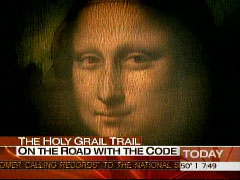 The news media play an important role in popular culture by providing
publicity for the movie studios as films are readied for release. But some
movies are more favored by the news media than others, some for their expected
status as expensive but appealing blockbusters, and some for their social
commentary (for example, the film Brokeback Mountain). The DaVinci
Code was both: an expected blockbuster movie based on one of the most
publicized works of fiction in the new century, drawing enormous national media
interest with its vision of a vast, murderous church conspiracy. It should not
be surprising that The DaVinci Code came roaring out of the box office
with a $77 million opening weekend.
The news media play an important role in popular culture by providing
publicity for the movie studios as films are readied for release. But some
movies are more favored by the news media than others, some for their expected
status as expensive but appealing blockbusters, and some for their social
commentary (for example, the film Brokeback Mountain). The DaVinci
Code was both: an expected blockbuster movie based on one of the most
publicized works of fiction in the new century, drawing enormous national media
interest with its vision of a vast, murderous church conspiracy. It should not
be surprising that The DaVinci Code came roaring out of the box office
with a $77 million opening weekend. Overall, NBC led in total stories with 52, followed by ABC with 26, and CBS
with 21. There were 16 evening news stories: ABC’s World News Tonight
aired five, the CBS Evening News ran six, and the NBC Nightly News
aired five. Two of NBC’s stories and one of ABC’s were brief anchor-read items.
Overall, NBC led in total stories with 52, followed by ABC with 26, and CBS
with 21. There were 16 evening news stories: ABC’s World News Tonight
aired five, the CBS Evening News ran six, and the NBC Nightly News
aired five. Two of NBC’s stories and one of ABC’s were brief anchor-read items. By contrast, The Passion of the Christ drew 11 evening-news stories
through the end of February 2004. On the morning shows, The Passion drew
40 segments (just three of them anchor briefs), 16 on ABC to 13 on CBS and 11 on
NBC. So while the NBC contrast on the morning news programs was large – 38 to
11, ABC (15) and CBS (14) carried almost the same amount of morning news
coverage on both films.
By contrast, The Passion of the Christ drew 11 evening-news stories
through the end of February 2004. On the morning shows, The Passion drew
40 segments (just three of them anchor briefs), 16 on ABC to 13 on CBS and 11 on
NBC. So while the NBC contrast on the morning news programs was large – 38 to
11, ABC (15) and CBS (14) carried almost the same amount of morning news
coverage on both films.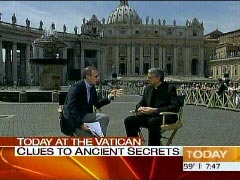 On NBC, Michael Medved made the divinity point in an August 10, 2005
interview. NBC also examined the point when Father Thomas Williams debated
Michael Baigent on Today March 28, and when Father Greg Apparcel was
interviewed in front of the Vatican on May 18: "But if you look at the idea of
perhaps no resurrection, no divinity, if you look at the Mary Magdalene issue
that you brought up. And to be quite honest with you, Father, I feel almost
awkward bringing this up here in St. Peter's Square, but the possibility that
Jesus had a physical relationship with Mary Magdalene. Is that particular
element the nuclear button when it comes to this book?" Even in front of the
Vatican, Lauer was still pushing that "nuclear button."
On NBC, Michael Medved made the divinity point in an August 10, 2005
interview. NBC also examined the point when Father Thomas Williams debated
Michael Baigent on Today March 28, and when Father Greg Apparcel was
interviewed in front of the Vatican on May 18: "But if you look at the idea of
perhaps no resurrection, no divinity, if you look at the Mary Magdalene issue
that you brought up. And to be quite honest with you, Father, I feel almost
awkward bringing this up here in St. Peter's Square, but the possibility that
Jesus had a physical relationship with Mary Magdalene. Is that particular
element the nuclear button when it comes to this book?" Even in front of the
Vatican, Lauer was still pushing that "nuclear button."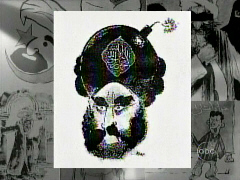 – Only ABC showed a cartoon in its entirety for a few seconds during World
News Tonight and on Nightline on February 2. "We felt you couldn't
really explain to the audience what the controversy was without showing what the
controversy was," said Jeffrey Schneider, a spokesman.
– Only ABC showed a cartoon in its entirety for a few seconds during World
News Tonight and on Nightline on February 2. "We felt you couldn't
really explain to the audience what the controversy was without showing what the
controversy was," said Jeffrey Schneider, a spokesman. 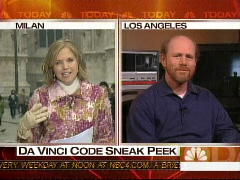 Then Couric took up religion, softly: "Some have called it an attack on
Christianity itself. A Vatican official called for a boycott of it. In taking on
the project, were you concerned about that?" Howard quickly insisted, "it’s
fiction. Dan Brown acknowledges that, I certainly do as the film’s director,"
and insisted the movie "can stimulate thought, discussion, and, in a
constructive way." Then Couric just asked about movie-making and how "we’re very
excited to see the clip" and concluded, "I think the rest of the world, I think,
probably, will be seeing the movie."
Then Couric took up religion, softly: "Some have called it an attack on
Christianity itself. A Vatican official called for a boycott of it. In taking on
the project, were you concerned about that?" Howard quickly insisted, "it’s
fiction. Dan Brown acknowledges that, I certainly do as the film’s director,"
and insisted the movie "can stimulate thought, discussion, and, in a
constructive way." Then Couric just asked about movie-making and how "we’re very
excited to see the clip" and concluded, "I think the rest of the world, I think,
probably, will be seeing the movie."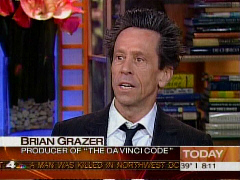 – On Opus Dei, Couric merely wondered, "have you considered their complaints
or viewpoints?" Grazer claimed improbably that "I think they’ll be happy with
the movie, ultimately," and said all of their films have had critics, including
Apollo 13 and the rap movie 8 Mile. Grazer didn’t really see any
big difference between his secular films and his film suggesting Christianity’s
God is a phony.
– On Opus Dei, Couric merely wondered, "have you considered their complaints
or viewpoints?" Grazer claimed improbably that "I think they’ll be happy with
the movie, ultimately," and said all of their films have had critics, including
Apollo 13 and the rap movie 8 Mile. Grazer didn’t really see any
big difference between his secular films and his film suggesting Christianity’s
God is a phony.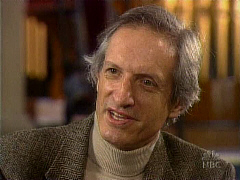 James: "Baigent admits he never met Lilly, who is dead. He’s never seen
the document. Nor does he have any idea what the document said. Even Baigent
concedes this story has a lot of holes."
James: "Baigent admits he never met Lilly, who is dead. He’s never seen
the document. Nor does he have any idea what the document said. Even Baigent
concedes this story has a lot of holes."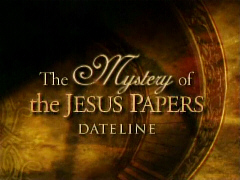 Then at the end, the Jesus-denying expert turned the show on its head. James
asked Baigent: "It strikes me that what you’re doing is asking us to take a leap
of faith." Baigent replied: "I suppose in one sense, that could be true."
Then at the end, the Jesus-denying expert turned the show on its head. James
asked Baigent: "It strikes me that what you’re doing is asking us to take a leap
of faith." Baigent replied: "I suppose in one sense, that could be true."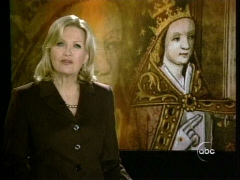 Sawyer’s syrupy prose continued throughout: "It is a story as old as the
cobblestones of Europe, as immediate as any woman’s ambition, any century’s
dreams...remember this is not a fairy tale. It is one of the world’s oldest and
most fascinating puzzles." She sees a modern parallel to this mythical church of
the ninth century. While Italians on the street acknowledge the female-Pope
legend, she said, "try asking those questions to some nuns and priests, and they
shy away. After all, take a look at the hierarchy of the Catholic Church today.
Women resolutely excluded from true circles of power."
Sawyer’s syrupy prose continued throughout: "It is a story as old as the
cobblestones of Europe, as immediate as any woman’s ambition, any century’s
dreams...remember this is not a fairy tale. It is one of the world’s oldest and
most fascinating puzzles." She sees a modern parallel to this mythical church of
the ninth century. While Italians on the street acknowledge the female-Pope
legend, she said, "try asking those questions to some nuns and priests, and they
shy away. After all, take a look at the hierarchy of the Catholic Church today.
Women resolutely excluded from true circles of power." 